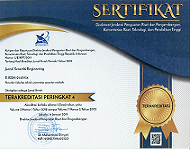Sintesis dan Karakterisasi Biodegradable Styrofoam Berbahan Dasar Tepung Singkong dan Selulosa Batang Singkong dengan Metode Thermopressing
Keywords:
biodegradable styrofoam, cassava flour, cassava stem cellulose, thermopressing, pva, characterizationAbstract
Environmental concerns arising from the accumulation of synthetic styrofoam waste have prompted the search for eco-friendly packaging alternatives. This study aims to synthesize and characterize biodegradable styrofoam made from cassava flour and cellulose extracted from cassava stems using the thermopressing method. Cellulose was obtained through delignification and bleaching of dried cassava stems sieved to 80 mesh. The synthesis process involved varying polyvinyl alcohol (PVA) concentrations (0–20% w/w) and molding temperatures (140–180°C). Characterization included water absorption, soil burial biodegradation, and tensile strength testing. The results showed that increasing PVA concentration and molding temperature reduced water absorption and improved tensile strength. The optimal formulation was achieved with 20% PVA and a pressing temperature of 180°C, resulting in 8.41% water absorption, 30.33% biodegradation after 30 days, and a tensile strength of 2.88 MPa. Although the tensile strength does not yet meet the Indonesian National Standard (SNI ≥29.16 MPa), the material demonstrates promising potential as a biodegradable alternative to petroleum-based styrofoam.
References
[1] Abubakar, Y., Anhar, A., Hamid, A.H. dan Nasution, A, ‘Peningkatan Produksi Bahan Pangan Singkong dengan Memanfaatkan Lahan Gambut di Gampong Kuala Baro, Kecamatan Kuala Pesisir, Kabupaten Nagan Raya’ Community Development Journal, 2(3), pp.829, 2021
[2] Haidar, A., Tamrin, Asmara, S. dan Bustomi, ‘Pengaruh Campuran Limbah Tongkol Jagung, Batang Singkong dan Batu Bara dengan Perekat Tapioka terhadap Kualitas Briket Biocoal’ J. Agricultural Biosystem Engineering, 1(2), pp. 247, 2022
[3] Utomo, Bagus Sediadi Bandol, Singgih Wibowo, and Tri Nugroho Widianto. ASAP CAIR: Cara Membuat & Aplikasinya Pada Pengolahan Ikan Asap. Penebar Swadaya Grup, 2012.
[4] Setiawan, D.P, Kartini, K.S, Putra, I.N.T.A. ‘Sosialisasi Video Animasi 2D Tentang Pengenalan Penggunaan Styrofoam dan Bahan Alami Dalam Pembuatan Ogoh-ogoh’, Jurnal Widya Laksmi, 1(1), pp. 32, 2021
[5] Utami, I., Rachmawati, F., Srianah, P., dan Triana, N. W., “Optimasi Proses Pembuatan Biofoam dari Jerami dan Kulit Singkong dengan RSM” Jurnal Teknik Kimia,18(2), P.140, 2024
[6] Akmala, A, dan Supriyo, E, ‘Optimasi Konsentrasi Selulosa pada Pembuatan Biodegradable Foam dari Selulosa dan Tepung Singkong’, Jurnal Pentana, 01(1), p. 27-40, 2020
[7] Sari, H. N., Biokomposit Berbasis Serat Sembukan (Paederia Foetida L.) -Pati Colocasia Esculenta, Deepublish Digital, Sleman, 2023
[8] Gbadeyan, O. J., Biomass-based Bioplastic and Film, Department of Chemistry University of Technology Durban, South Africa, 2024
[9] Rijal, M., Surati, Rosmawati, Natsir, M. A., Tomia, R., Keliandan A., Limbah Sagu dan Tahu Sebagai Alternatif Bahan Bioplastik, Uwais Inspirasi Indonesia, Ponorogo, 2025
[10] Mahfud, A. M., Asfar, A. M. I. T., Asfar, A. M. I. K., Safar, M., Nurannisa, A., dan Yani, A., Delignifikasi Limbah Pertanian Menjadi Ransum Organik, KBM Indonesia, Indonesia, 2024
[11] Santhi M., Arnata I. W., dan Wrasiati L. P., ‘Isolasi Selulosa dari Serat Sabut Kelapa (Cocos nucifera L.) pada Variasi Suhu dan Waktu Proses Bleaching dengan Asam Perasetat’, Jurnal Rekayasa dan Manajemen Agroindustri, Vol. 10(3), 2022
[12] Tarigan, R. A. P., Pramita, A., Hastuti, S., dan Nurhilal, M., (2024), 'Pengaruh Delignifikasi Alkali terhadap Perubahan Struktur Lignoselulosa Serbuk Sabut Kelapa sebagai Pengisi Komposit Geopolimer', Jurnal Rekayasa Mesin, Vol. 19(3), p. 403-410
[13] Bahri, S., Fitriani, F. and Jalaluddin, J. (2021) ‘Pembuatan Biodegradable foam Dari Ampas Tebu Dan Tepung Maizena’, Jurnal Teknologi Kimia Unimal, 8(1), p. 24
[14] Rusdianto, A. S., Amilia, W., dan Nurjannah, R. N., (2024), ‘Synthesis of Biofoam Based On Glucomannan Porang and Polyvinyl Alcohol (PVA) with The Addition of Seaweed Dregs’, International Jpurnal on Food, Agriculture, and Natural Resources, Vol. 5(03). Pp. 91-97
[15] Cornellia, A.D. et al. (2023) ’Kombinasi Jerami dan Ampas Tebu Sebagai Biofoam High Durability dan Waterproof dengan Metode Mixing dan Molding’, Jurnal Multidisiplin Ilmu, 2(2), p.49-54
[16] Putri, M., Putri, D. K., dan Putri, A., ‘ Penambahan Gliserin dan Polivinil Alkohol Terhadap Karakteristik Biofoam dari Kulit Singkong dan Daun Angsana’, Journal Of Research On Chemistry And Engineering, 2(1), p. 15-18, 2021
[17] Akmala, A, dan Supriyo, E.,‘Optimasi Konsentrasi Selulosa pada Pembuatan Biodegradable Foam dari Selulosa dan Tepung Singkong’, Jurnal PENTANA, 01(1), p. 27-40, 2020
[18] Hendrawati, N., Dewi, E.N. and Santosa, S., ‘Karakterisasi Biodegradable Foam dari Pati Sagu Termodifikasi dengan Kitosan Sebagai Aditif’, Jurnal Teknik Kimia dan Lingkungan, 3(1), p. 47, 2019
Downloads
Published
Issue
Section
License
Copyright (c) 2025 Mochammad Rasyiid Febrianto, Laily Tazkiyah, Dyah Suci Perwitasari (Author)

This work is licensed under a Creative Commons Attribution 4.0 International License.












